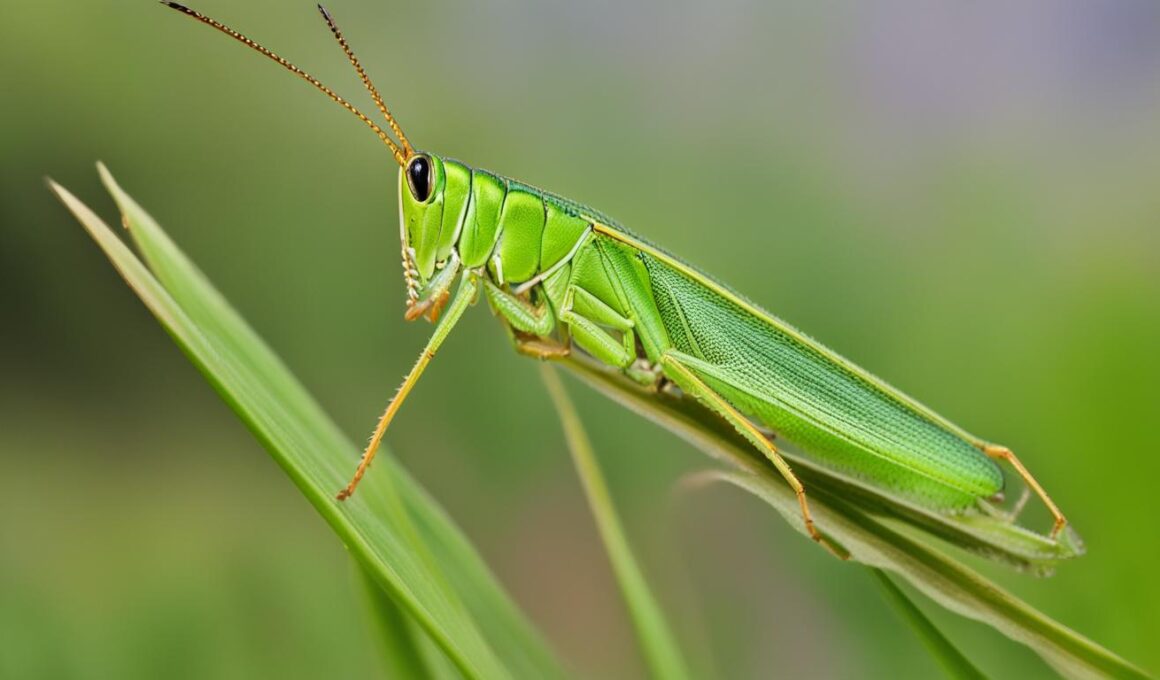If you’ve ever wondered whether grasshoppers really eat grass, you’re not alone. The name itself suggests that these creatures have a diet solely comprised of grass. However, the reality is far more interesting and complex. While some grasshoppers do indeed consume grass as their primary food source, others have more diverse diets. In fact, there are around 11,000 known species of grasshopper, each playing a unique role in different ecosystems.
So, what determines the dietary habits of grasshoppers? It turns out that their mouthparts, known as mandibles, play a crucial role in their diet diversity. Some grasshoppers have mandibles adapted for grinding tough foods like grass, while others have mandibles with sharper cutting edges. This variation in mouthpart structure allows different species of grasshoppers to consume a range of food sources.
Recent research conducted by palaeobiologists at the University of Leicester has shed light on the correlation between grasshopper mouthparts and diet diversity. Using innovative three-dimensional imaging techniques, they were able to map the shape of grasshopper mandibles and identify distinct variations related to different diets. By comparing the mandible landscapes of grasshoppers with the teeth of mammals, scientists can now predict grasshopper diet with an impressive 82% accuracy.
Traditional methods of studying grasshopper diets have had limitations, but researchers have found a solution. They have now turned to a technique called real-time PCR (polymerase chain reaction), which allows for the detection and measurement of specific DNA sequences in the guts of grasshoppers. By designing primer sequences for specific host plants and quantifying the DNA of these plants in grasshopper guts, researchers can gain valuable insights into grasshopper diet structure and food preferences.
As our understanding of grasshopper diets continues to evolve, we are discovering that these fascinating insects have a much wider range of feeding habits than previously thought. From grass to various plant materials, and even other animals, grasshoppers play a vital role in ecosystems. This knowledge is crucial for effective pest management and ecological research, helping us better understand the impact of grasshoppers on our environment.
In conclusion, the study of grasshopper diets provides us with valuable insights into these remarkable creatures. By uncovering their feeding behaviors and ecological roles, we can make informed decisions to protect our crops, maintain balanced ecosystems, and ensure the survival of all species.
Grasshopper Mouthparts and Diet Diversity
The mouthparts of grasshoppers, known as mandibles, play a crucial role in their feeding habits. These mandibles vary in structure according to the grasshopper’s diet preferences, reflecting the diversity of their diets.
- Some grasshoppers have molar-like mandibles that are adapted for grinding tough foods like grass.
- Other grasshoppers possess mandibles with sharper cutting edges, allowing them to consume a broader range of plant materials.
This variation in mouthpart structure enables grasshoppers to adapt to different food sources and thrive in various environments.
A recent study conducted by palaeobiologists at the University of Leicester used innovative three-dimensional imaging techniques to map the shape of grasshopper mandibles. This research revealed clear differences in mandible structure associated with distinct diets.
The study’s findings demonstrated that by comparing the landscapes of grasshopper mandibles with the teeth of mammals, scientists can predict grasshopper diet with an impressive 82% accuracy. This breakthrough in research techniques provides valuable insights into the feeding habits of grasshoppers and contributes to our understanding of their ecological importance.
By investigating grasshopper mouthparts, scientists can gain a deeper understanding of the relationship between mandible structure and diet diversity. This knowledge helps elucidate the role of grasshoppers in ecosystems and highlights the need for more precise and efficient methods to investigate their diets.
Grasshopper Diet Investigation Using Real-Time PCR
Traditional methods of studying grasshopper diets have limitations, such as long experimental periods, qualitative measurements, and population-level effects only. To overcome these limitations, researchers have started using real-time PCR (polymerase chain reaction) to examine the diets of individual grasshoppers.
Real-time PCR is a fast and quantitative method that allows for the detection and measurement of specific DNA sequences in the guts of grasshoppers. This technique has been successfully employed to determine the food intake and preferences of grasshoppers.
By designing primer sequences for specific host plants and quantifying the DNA of these plants in grasshopper guts, researchers can gain valuable insights into grasshopper diet structure and food preferences.
This method offers a more accurate and individual-level understanding of grasshopper diets, which can contribute to improved pest management and ecological research.
Can Grasshoppers Actually Consume All the Grass in the World?
Many people wonder about the likelihood of grasshoppers counting global grass population and consuming all the grass in the world. While grasshoppers can be voracious eaters, it’s unlikely that they would be able to eradicate all the grass on Earth. Despite their ability to damage crops, the sheer volume of grass would make this feat impossible.
Conclusion
Grasshopper diet research has revealed fascinating insights into the feeding habits and ecological roles of these insects. Contrary to popular belief, grasshoppers have a much more diverse diet than previously thought. While some species primarily consume grass, others have evolved to eat different types of plant materials or even engage in carnivorous behavior.
The relationship between grasshopper mouthparts and diet diversity has been a particularly interesting area of study. Scientists have discovered that variations in the structure of grasshopper mandibles are closely linked to their specific diet preferences. This discovery has provided valuable insights into the complex feeding behaviors of grasshoppers and their importance in maintaining ecosystem balance.
The use of innovative techniques such as three-dimensional imaging and real-time PCR has significantly advanced grasshopper diet research. Scientists can now study these insects’ diets more accurately and efficiently, leading to a better understanding of their ecological impact and aiding in the development of effective pest management strategies. This knowledge is critical for protecting natural habitats and minimizing potential agricultural damage caused by grasshopper populations.
Continued research into grasshopper diets will contribute to a deeper understanding of these fascinating insects and their role in ecosystems. By expanding our knowledge of their feeding habits and preferences, we can further enhance our ability to conserve and manage grasshopper populations in a sustainable manner.









